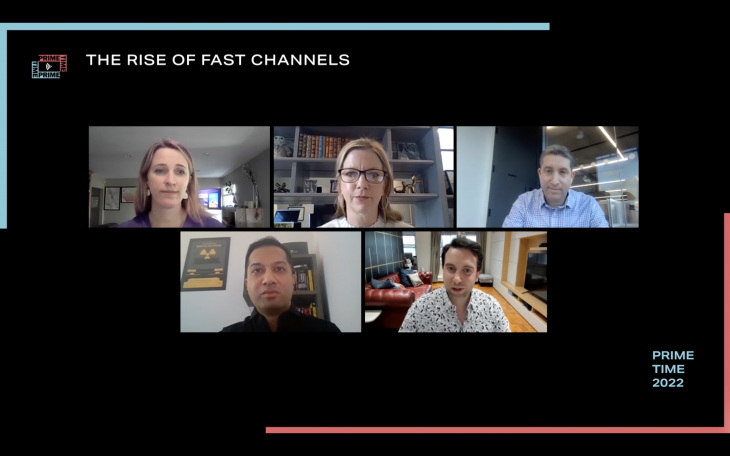
By Ken Kelley
AS BROADCASTERS AND CONTENT providers weigh the long-term implications of subscription and streaming fatigue among the general public, a different medium is making waves.
Free ad-supported streaming television, or FAST, is similar to linear cable television channels in that commercials play throughout a program. The medium offers pre-programmed channels that are joined in progress by viewers.
FAST is growing in leaps and bounds. In the United States alone, there are more than two dozen FAST services, including Pluto TV, Roku and Tubi TV, while according to data from Wurl, FAST ad impressions have grown by 16 times since January 2020.
So, what does the future hold for FAST? This was the topic of discussion during the panel The Rise of FAST Channels at the CMPA’s virtual Prime Time conference on Monday, which was moderated by Gavin Bridge (above, bottom row right), senior media analyst at Variety VIP+.
Ashley Hovey (top row left), head of the Roku Channel, believes there are a number of reasons why FAST is seeing such phenomenal growth.
“It’s free. Who doesn’t like free,” she rhetorically asked her fellow panelists. “That really helps drive down cost in the household because there’s no barrier to entry. Second, EMarketer released a study that showed less than half of Canadian households are expected to have pay TV by 2022. We’re seeing that decline [but] people still want to be able to have that lean-back experience with the news, sports and entertainment content they want, and they’re able to find it in FAST.”
Hovey believes another key factor in FAST’s ever-increasing popularity has to do with familiarity. She contends that while on demand remains a vital component of the present-day entertainment experience, the public also enjoys going into a service to find the brands they love and being able to have an experience with something they trust that is curated for them.
Tejas Shah (bottom row left), FilmRise’s senior vice-president of commercial strategies and analytics, believes the customization and personalization options within FAST and being able to key in on genres important to the audience and being able to program for them has given the service a distinct advantage over traditional television.
FilmRise is a familiar name in the world of FAST channels. Founded in 2012, the service has become a leader in the market, offering more than 40,000 licensed and original films and television episodes spanning all genres.
“I think one way that traditional television lost its way is that you saw, for example, an independent film channel seven years into its run begin playing re-runs of true crime shows,” Shah said. “Ultimately, that’s not independent films. We’re providing audiences what they want and providing them more curated experiences.”
Blue Ant Media’s president of global channels and media, Jamie Schouela (top row right), said his company has consistently catered to niche audiences, making the company’s foray into FAST a natural fit.
“FAST gave us an opportunity on a global scale to lean into niches, some of which we already played in on the pay TV side, while others are completely new niches,” he said.
“But you have to understand how to connect with audiences. One of the other things [I feel] we bring to the table is the same team that schedules, curates and markets the pay TV channels brings that expertise to the FAST side of the business. We treat our FAST channels with the same TLC as our pay television channels. They are different distribution platforms but the fundamentals on how to connect with an audience are very much the same.”
Amy Kuessner (top row middle), senior vice-president of content strategy and global partnerships at ViacomCBS Streaming, noted that her company’s Pluto TV service surpassed $1 billion in revenue in 2021 after just seven years in business.
“When I joined the company five years ago, we weren’t even monetizing, so that really speaks to the industry and our business in particular,” Kuessner said.
Being able to harness viewer data on an almost real-time basis has played an important part of Pluto’s success, she says, noting they are reliant on that data to see what’s performing across the platform and then work to provide more of it. Conversely, it also allows the content team to start weening off channels and content that is not performing.
But with the proliferation of FAST services, the panelists agreed searching out original content and being able to differentiate their platform from others will remain vital to their sustained success.
“What FilmRise has found in the opportunity to be data-driven to find the signals on what is consumer sentiment and what are under-exploited shows that haven’t been digitally exploited,” Shah said. “Taking a Canadian show like Kim’s Convenience and bringing them to an American audience has been an exciting advent of this whole industry.”



